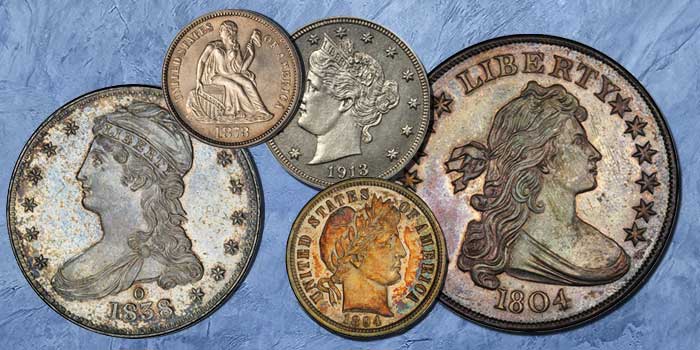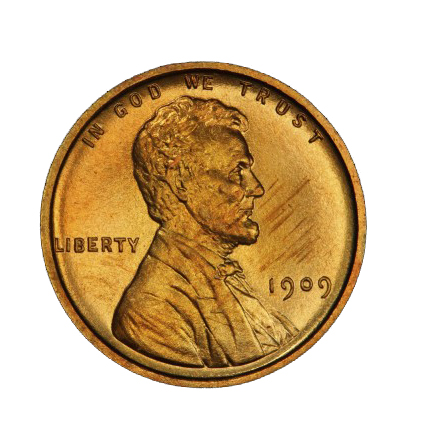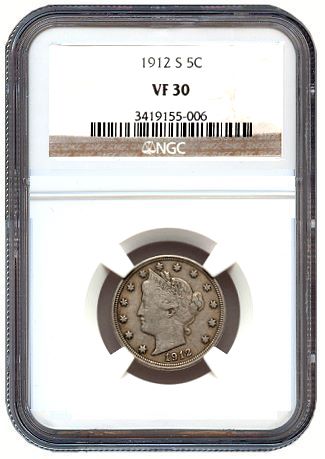
By Jeff Garrett for Numismatic Guaranty Corporation (NGC) ……
When I started my full-time career in numismatics around 1977, numismatic rarity was measured against five coins. Everything else was compared with them and was worth considerably less.
The top three coins at the time were the:
- 1804 Silver Dollar
- 1913 Liberty Nickel
- 1894‐S Barber Dime
The next tier consisted of the 1876‐CC Twenty Cent piece and the 1838‐O Half Dollar.
All five of these issues are featured prominently in my book, 100 Greatest United States Coins. The 1804 Silver Dollar consistently ranked No. 1 or 2 among polls of dealers.
In the early years of my career, these prime rarities only sold when old-time, legacy collections entered the market. Most of the coins had been in collections for decades. Some collections, such as Garrett (no relation, unfortunately) had been formed starting in the late 1800s.
For a full study of this period, you can look through the auction catalogs of Stack’s and of Bowers and Merena. Those two companies sold a majority of the great collections in the late 1970s and ’80s. RARCOA and Paramount sold some important collections, but nothing compared to the first two. Heritage did not even get started until the mid‐1980s.
The United States series are full of important rarities, but none dominated this period like the above-mentioned five coins. They were blockbusters and made headlines and filled rooms when they crossed auction blocks. Very few collections contained all of these great coins. The Elisaberg collection sold by Bowers and Merena was nearly complete and featured all of these rarities when it was sold.
During the ANA World’s Fair of Money in Chicago a couple of weeks ago, a few of these anchor rarities crossed the auction block, including a PF 63 1894‐S Dime and an MS 65 1876‐CC Twenty Cent piece. The 1894‐S Dime sold for $1.3 million and the 1876‐CC Twenty Cent sold for more than $450,000.
In the late 1970s and early ’80s, examples of the 1913 Liberty Nickel and the 1804 Silver Dollar sold for about $200,000. These sales generated a huge amount of publicity.
John Hamrick of World Wide Coin in Atlanta purchased both of these coins at one time and told me that he was able to generate an enormous amount of free publicity for his company by simply owning them. They would create a big stir at conventions when they were exhibited.
Today, some 40 years later, these two coins now go for about $3 million when they are sold at auction or in private transactions. This works out to about a 7% return on your investment. Not bad, but this pales in comparison to much-lesser-known rarities in high grade.
Today’s “Big” Coins
Recently, a superb 1909 VDB Cent graded NGC PF 65 RD sold for $32,000. The coin was worth about $400 in the late 1970s. The 1938-S MS 68+ Mercury Dime that sold in June in a Legend Rare Coin Auctions sale for $364,250 probably would have sold for less than $20 in the 1970s. There are dozens and dozens of examples of coins that now sell for 100 or more times the price they could have sold for 40 years ago. Most of this is based on the extreme premium the market now places on quality.
 A lot of this demand is created by collectors competing in Set Registry collections. The extra points that a finest-known coin provides drives buyers to pay prices that would have been unthinkable 40 years ago. If given a time machine, I would go back to hand‐pick amazing gem coins for almost nothing and save them for retirement. Unfortunately, with that seemingly unlikely, we are forced to consider what the best value is today.
A lot of this demand is created by collectors competing in Set Registry collections. The extra points that a finest-known coin provides drives buyers to pay prices that would have been unthinkable 40 years ago. If given a time machine, I would go back to hand‐pick amazing gem coins for almost nothing and save them for retirement. Unfortunately, with that seemingly unlikely, we are forced to consider what the best value is today.
Very few of us can consider buying one of the Big Five. They may be great values in relation to other coins, but prices in the hundreds of thousands of dollars put them beyond the reach of all but a handful of wealthy collectors.
Collectors can, however, buy coins with true rarity. They are attractive for a number of reasons.
Collectors will always need the “key” coins of any series to complete sets. This will ensure demand for these issues as long as people collect coins. Coins such as the 1916 Standing Liberty Quarter, the 1893‐S Morgan Dollar, the 1911‐D Quarter Eagle and many more will always be in demand. Many of these issues are also now selling for bargain prices. Many collectors seeking extreme quality have ignored “key” dates in average condition.
 Rare issues will always be rare. In most cases, it is extremely unusual for hoards or mini-hoards of rare dates for most series to show up. An exception to this occurred in the last few years when a roll or more of choice 1909‐S VDB Cents and 1912‐S Liberty Nickels entered the market. These two coins now sell for much less than a few years ago and should be seriously considered for purchase. Both groups have been completely absorbed by the market at this point.
Rare issues will always be rare. In most cases, it is extremely unusual for hoards or mini-hoards of rare dates for most series to show up. An exception to this occurred in the last few years when a roll or more of choice 1909‐S VDB Cents and 1912‐S Liberty Nickels entered the market. These two coins now sell for much less than a few years ago and should be seriously considered for purchase. Both groups have been completely absorbed by the market at this point.
Nearly every series has coins that can be considered true rarities. This offers opportunities for collectors to do research to identify undervalued coins within each denomination or series. For example, many Southern Branch Mint gold coins with good eye appeal are very difficult to find, regardless of the grade. The same can be said for Bust coinage, Seated coinage and many others.
Most rarer coins have great stories attached to them, and this makes them much more interesting to collect. The 1916 Standing Liberty Quarter was supposedly withdrawn due to concerns about the lack of modesty of the original design. These stories are what make coin collecting a great hobby.
When considering how to spend your hard-earned money in numismatics, I highly recommend that you consider rarity as one of your first priorities. Many of the coins are great values at today’s prices, and you will enjoy the pursuit!






I collected in the 70s one coin that stands out above all of your five is the 1933 saint gaudens dollar Tul truly a sight to behold in the 1970s none were known to the US citizens.
Made even rarer due to the government meltdown of gold post-1932. The ’33 Saint Gauden’s is rare but probably illegal to sell as it became illegal to own (was never released for circulation or collector purchase and only known examples were retained for posterity sake). Known examples have been confiscated in the past.
The 1933 Saint-Gaudens is uncollectible unless you want to risk Secret Service personnel storming your home or office. Unless the Langbord 10 are released, there is only 1 privately owned coin plus a few others that secretly trade in the black market and Europe.